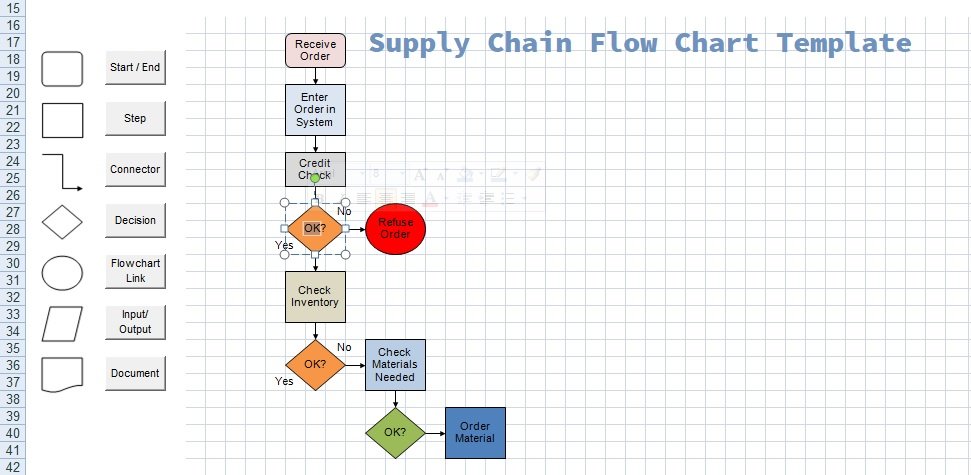All the products pass through different processes for the transformation from the raw material to the end product. This end product manufactured at some production facility involves a complete chain of logistics.
Thank you for reading this post, don't forget to subscribe!The supply chain flow chart involves the flow of different things over the whole supply chain and all the supply chain management processes such as production planning, supply chain planning, and material requirement planning.
5 Steps of Supply Chain Flow Chart
There are five steps in the Supply chain flow chart that are;
- Procurement
- Material Management
- Production
- Order Receiving Management
- Distribution and Delivery
In the procurement phase, we buy raw materials from a supplier. After that material management involves accession of material, inspection, and storage of raw materials. Then comes production this phase refers to the manufacturing of goods and items from raw materials.
In Order to receive management, we set up a professional team that is responsible to handle the order and provide necessary information to the dispatch department. In the step of distribution and delivery, we plan a flawless process of delivery of products and goods.
This supply chain flow chart assists us in how we can manage end-to-end product delivery?
How do we plan supply chain management? Things to do and what kind of actions we need to do.
Furthermore, if we want to make this supply flow more efficient and proactive, this flow chart template helps us to identify which step of the supply chain process can we boost to get better output.
We should also inspect each activity to identify, which part we can put an improvement plan to boost the supply chain flow process.
Types of Flows in Supply Chain Flow Chart Template

Supply chain management (Templates) involves a lot of stakeholders in the whole chain from the raw material to the product delivered. A variety of materials, goods, resources, and information is transferred in the whole chain within the horizontally integrated and vertically integrated businesses.
There are three main types of flows involved in the process of supply chain management;
- The flow of Material / Goods
- The flow of Data / Information
- The flow of the money
The flow of the material involves a range of stakeholders from the procedure to the end-user. It includes the manufactures inventory, and warehouses of distributors, dealers, and retailers.
The smooth flow of material from the inventory of each stakeholder improves the cash flow among the stakeholders. The quick flow of the material is desired by each manufacturer, distributor, and dealer.
The flow of material also involves the backflow of material from the clients to the producers in case of any required repair or exchange. The 3PL process is used to handle such scenarios in supply chain management.
How to Develop Supply Chain Flow Chart Template?
Supply chain flow chart templates are usually easy to develop using Microsoft Visio. Still, Excel spreadsheets can also hold enough tools to develop effective and efficient supply chain flow chart templates.
- These templates are easy to use, user-friendly, and customizable as per the business position.
- It is important to understand the supply chain flow chart effectively.
- It is also managing all the supply chain processes and getting full advantages of supply chain management.
- In terms of the feedback system and customer satisfaction.
- A supply chain management chart template involves a lot of stakeholders in the process such as manufacturers, dealers, retailers, and end-users.
- The process is managing the flow of all the information, materials, and goods. Besides all key stakeholders is referred to as supply chain flow management.
- Supply chain flow chart templates are developed by different businesses with reference to their position in the supply chain.
The Supply Chain Flow Chart Template management process utilizes a visual/graphical representation for an easy understanding of the information.
Supply Chain Flow Chart Example
Information flow among the stakeholders is really important to maintain the balance and ensure the quick flow of material.
- It involves all the documentation required such as quotations, proforma invoices, order confirmations, commercial invoices, shipping documents, production schedules, complaints, and reports.
- The reverse flows also involve offers, confirmations to purchase orders, and actions to reports.
- The flow of the money comes at the end after the information and material flow. This flow is maintained and recorded by information flow integrated with the material.
- Money is transferred in the form of cash, cheques, T.Ts, and L.Cs. From the producer to the clients, it involves the debit notes against claims and other money back schemes.
As well as and sales to supply the product in the consumer’s hands. Supply chain management is a process that controls, tracks, and manages the whole chain of raw material transformation and supply to the consumer.




